MSI 970 Gaming Motherboard Review: Undercutting AM3+ at $100
by Ian Cutress on January 22, 2015 10:00 AM EST- Posted in
- Motherboards
- AMD
- MSI
- Vishera
- AM3+
CPU Performance
Readers of our motherboard review section will have noted the trend in modern motherboards to implement a form of MultiCore Enhancement / Acceleration / Turbo (read our report here) on their motherboards. This does several things, including better benchmark results at stock settings (not entirely needed if overclocking is an end-user goal) at the expense of heat and temperature. It also gives in essence an automatic overclock which may be against what the user wants. Our testing methodology is ‘out-of-the-box’, with the latest public BIOS installed and XMP enabled, and thus subject to the whims of this feature. It is ultimately up to the motherboard manufacturer to take this risk – and manufacturers taking risks in the setup is something they do on every product (think C-state settings, USB priority, DPC Latency / monitoring priority, memory subtimings at JEDEC). Processor speed change is part of that risk, and ultimately if no overclocking is planned, some motherboards will affect how fast that shiny new processor goes and can be an important factor in the system build.
As it stands, it would seem that while the MSI 970 Gaming does not implement any form of MultiCore Turbo, its turbo mode is a lot more aggressive than our previous data points in most benchmarks.
Point Calculations – 3D Movement Algorithm Test: link
3DPM is a self-penned benchmark, taking basic 3D movement algorithms used in Brownian Motion simulations and testing them for speed. High floating point performance, MHz and IPC wins in the single thread version, whereas the multithread version has to handle the threads and loves more cores. For a brief explanation of the platform agnostic coding behind this benchmark, see my forum post here.
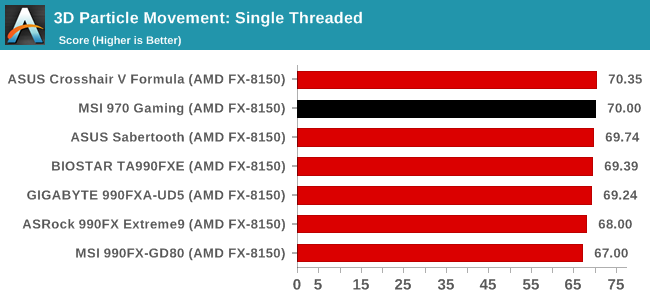
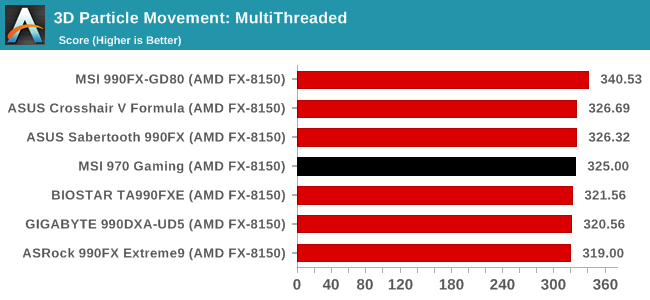
‘More aggressive turbo’ for 3DPM means a 2% jump in both ST and MT scores over the Extreme9.
Compression – WinRAR 5.0.1: link
Our WinRAR test from 2013 is updated to the latest version of WinRAR at the start of 2014. We compress a set of 2867 files across 320 folders totaling 1.52 GB in size – 95% of these files are small typical website files, and the rest (90% of the size) are small 30 second 720p videos.

One benchmark where the turbo fails is in WinRAR, which uses a multithreaded load. We tracked the CPU MHz during this test and it did not show anything toward, perhaps indicating a more auto-memory timing issue. The 970 does come as standard with a slower HyperTransport link, which might be one of the reasons for the discrepancy.
Image Manipulation – FastStone Image Viewer 4.9: link
Similarly to WinRAR, the FastStone test us updated for 2014 to the latest version. FastStone is the program I use to perform quick or bulk actions on images, such as resizing, adjusting for color and cropping. In our test we take a series of 170 images in various sizes and formats and convert them all into 640x480 .gif files, maintaining the aspect ratio. FastStone does not use multithreading for this test, and thus single threaded performance is often the winner.
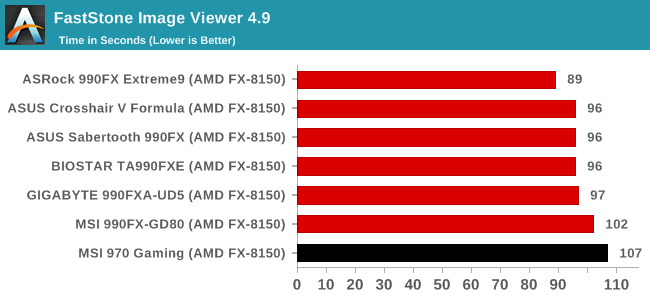
In line with the WinRAR result, the FastStone result was down the pan compared to the Extreme9 and other 900 series boards. FastStone is typically all CPU MHz related, especially single thread, which shows perhaps something fundamental with the 970 Gaming BIOS coding.
Video Conversion – Handbrake v0.9.9: link
Handbrake is a media conversion tool that was initially designed to help DVD ISOs and Video CDs into more common video formats. The principle today is still the same, primarily as an output for H.264 + AAC/MP3 audio within an MKV container. In our test we use the same videos as in the Xilisoft test, and results are given in frames per second.
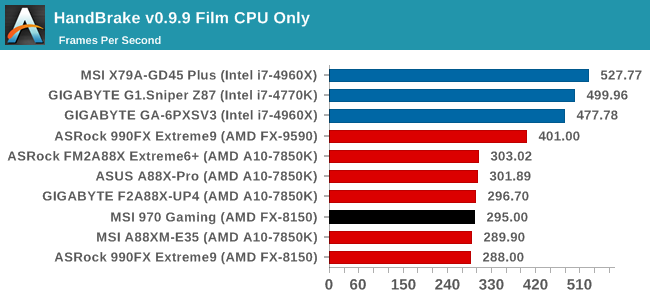
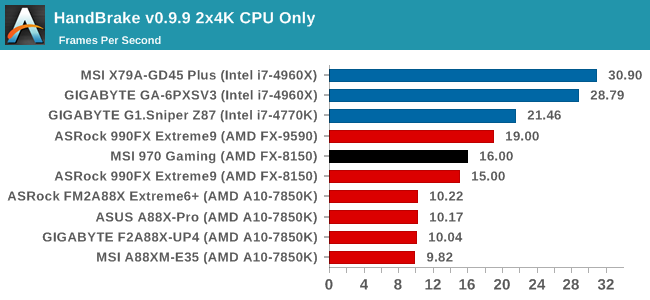
When the system ramps up all the cores, performance from the board is back on track, giving the same percentage increases over the Extreme9 as in the 3DPM benchmark.
Rendering – PovRay 3.7: link
The Persistence of Vision RayTracer, or PovRay, is a freeware package for as the name suggests, ray tracing. It is a pure renderer, rather than modeling software, but the latest beta version contains a handy benchmark for stressing all processing threads on a platform. We have been using this test in motherboard reviews to test memory stability at various CPU speeds to good effect – if it passes the test, the IMC in the CPU is stable for a given CPU speed. As a CPU test, it runs for approximately 2-3 minutes on high end platforms.
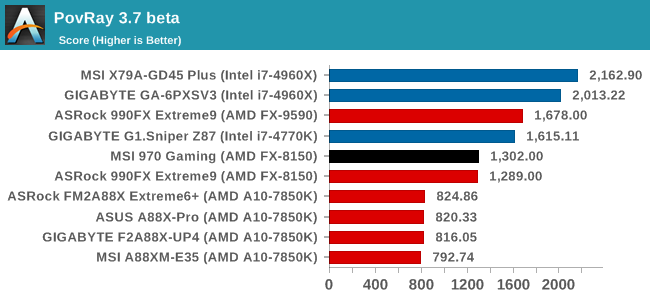
Synthetic – 7-Zip 9.2: link
As an open source compression tool, 7-Zip is a popular tool for making sets of files easier to handle and transfer. The software offers up its own benchmark, to which we report the result.
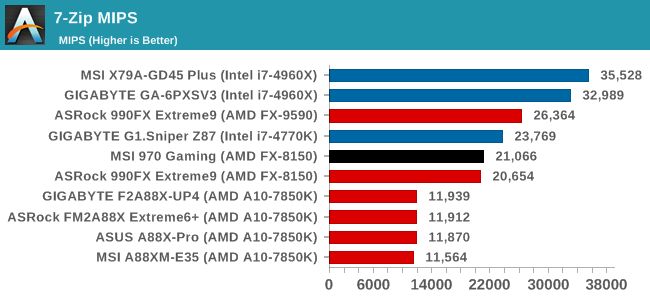










37 Comments
View All Comments
Samus - Thursday, January 22, 2015 - link
Not a bad price for such a complete board, even if the chipset is 4 years old.R3MF - Thursday, January 22, 2015 - link
the new asrock 970 fatality board looks better to be frank.no silly atheros 'killer' network cocket with dubious linux support
20Gb/sec m.2 slot
support for 220W CPU's
Ranari - Thursday, January 22, 2015 - link
I'm going to chalk this up as me being a terrible reader, but I was confused reading this review. Does this motherboard support 220W CPUs or not? Or is it limited to just 125W range?silverblue - Thursday, January 22, 2015 - link
Ian pointed this out to AMD; I doubt it does. It does support up to and including the 8370 though if their compatability list is to be believed.I'm not sure who'd want to throw a 220W CPU into any board let alone a 970, though.
FlushedBubblyJock - Sunday, February 15, 2015 - link
I ran a dedicated 10guage Romex line, 30 amper, to my 4.23 Vishy w/ my OC 290X and all was good my killawatt was reading 890wattts but then it tore down my 3000joule clamping voltage surge protector. :-(Luckily I had the fire extinguisher handy just in case.
Killrose - Thursday, January 22, 2015 - link
I beleive MSI is getting 2 x 8 PCI-e for SLI / Crossfire out of the 970 chipset on this motherboard although it is not supported by AMD, is this true?frenzy55 - Wednesday, January 28, 2015 - link
Yes this is true, this mobo supports SLI and Crossfire.failquail - Friday, January 23, 2015 - link
Could be a nice cheap replacement for my current motherboard that is experiencing a slow and painful death.(Asus Crosshair IV formula, AMD 890FX
Current status:
8/12 of the USB2 ports non-functional
USB3 ports dead
RAID controller dead
Jmicron ESATA/SATA extra controller dead
The rest of the board is still going, but i'm unsure how long for...)
Regarding the killer NIC: does this simply function as a standard LAN port if you don't install their software?
tekphnx - Friday, January 23, 2015 - link
Voltage by offset only, and no LLC, on a 'gaming' motherboard, is very disappointing. For $100, this board's other shortcomings could be forgiven, but as it stands, one would do better to stick to a standard 970 board at around $85. As for 990FX, unless someone already owns a 6000 or 8000 series CPU, investing $130+ for a 990FX board on the rather dated AM3+ platform at this point is a pretty foolish move vs. what Intel has to offer.MrFrogSD - Monday, January 26, 2015 - link
As someone who prefers smaller (read mATX) systems, it's been a real disappointment that no one has come out with any decent AM3+ mATX motherboards in the last several years. For those of us with limited space, we're pretty much forced to use FM2 or Intel at lower performance or higher cost.